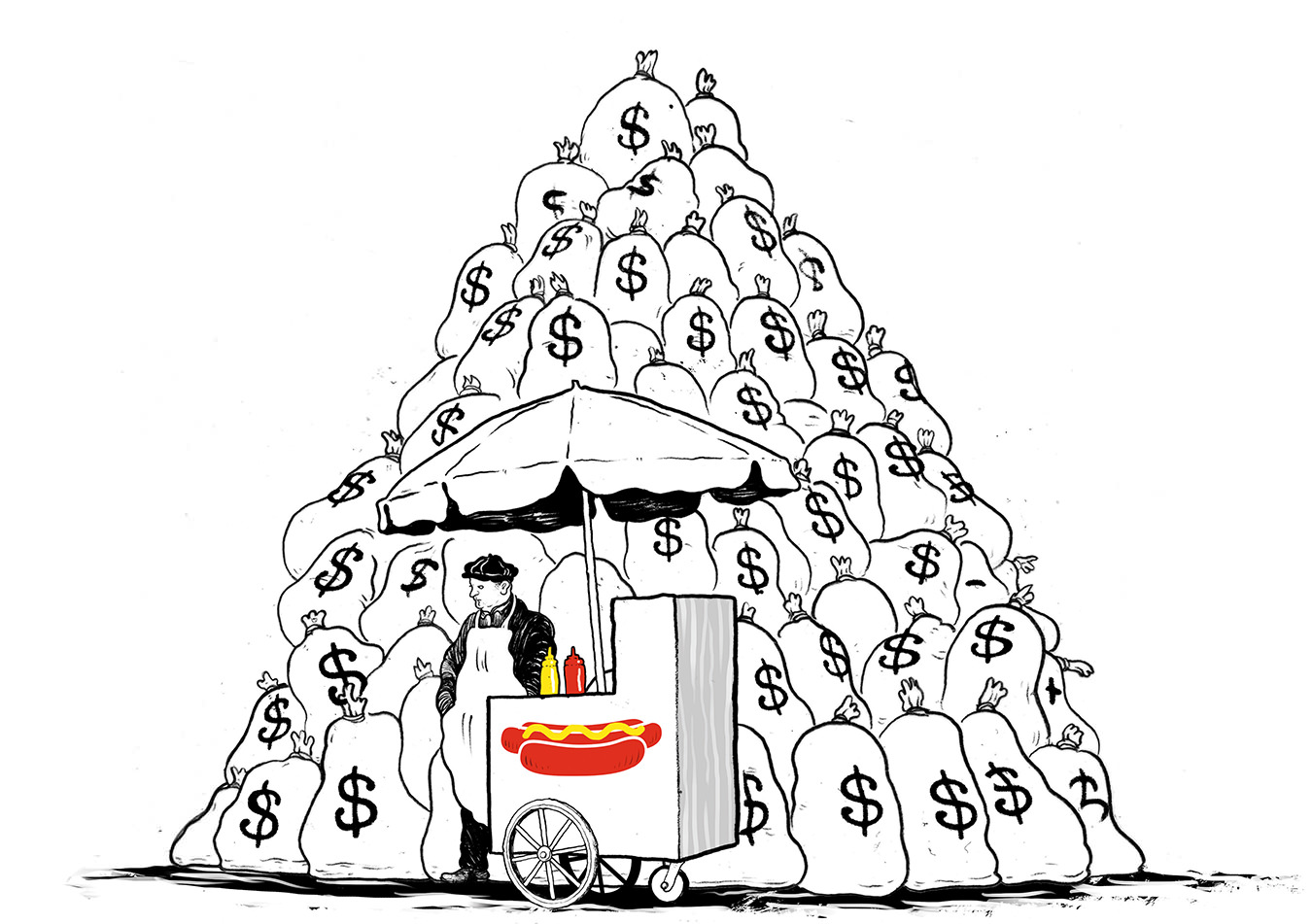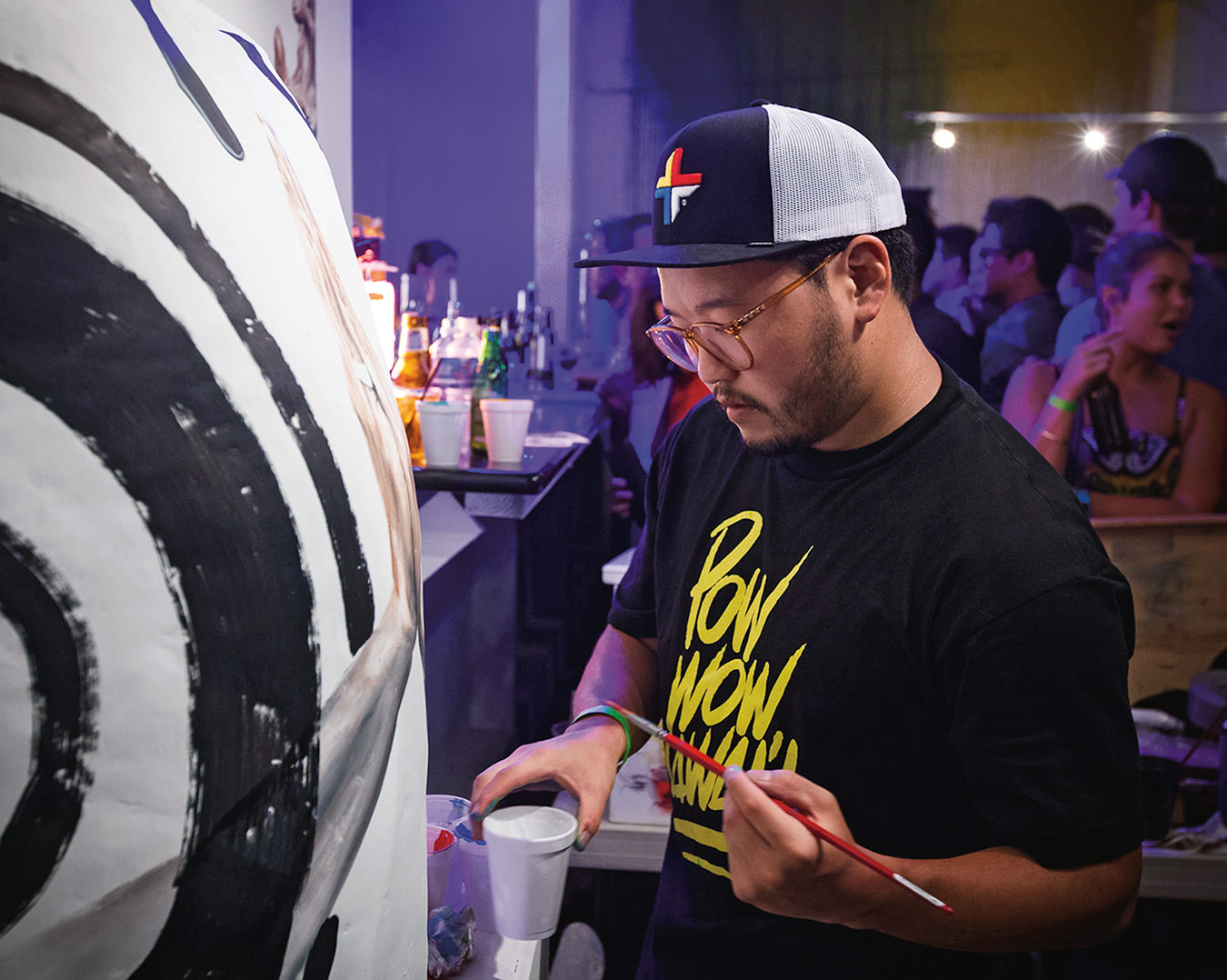Vision Critical’s Angus and Andrew Reid
Poll position.

Christy Clark is on the run. Chased by TV cameras that catch only her retreating back, the British Columbia premier is making her escape through the kitchen of the Hyatt Regency Vancouver while reporters bounce futile questions off her phalanx of handlers, questions about a new poll with some bad numbers. Not for the first or last time, a Canadian politician is running from Angus Reid.
Blocks away, in a seventh-floor office looking out over Vancouver’s Cambie Street Bridge, Angus shrugs. He seems almost apologetic. Creating strife or fleeting joy for governments or their opponents offers him no more satisfaction than a tornado might take in a devastated trailer park. His attitude reflects more than just the professional impartiality of a pollster. Despite decades in which Angus Reid polls have functioned like the political equivalent of Simon Cowell, politics has long ceased to be Reid’s main concern.
Since 2003, Angus has been with Vision Critical, the market research company started by his son, Andrew, in 2000. Angus first joined as an advisor, and became CEO the following year (he became chairman in 2011). Together, the Reids have built an $85-million business by helping companies find out just what their customers think about phone service, or in-flight meals, or a new fall clothing line, or the rules of a stock car race, or a new cinnamon-flavoured cereal—all without interrupting a single family meal or Glee episode. For Angus and Andrew Reid, the money is in marketing. Sending premiers fleeing through hotel kitchens? Just a loss leader.
The Angus Reid name can still strike fear into political hearts, like that trailer park–bound twister. But it’s Andrew Reid who is Vision Critical’s real rainmaker. Although growing up in the Reid household was itself an education in public opinion research, young Andrew opted instead for Vancouver Film School, followed by a stint at Frank Palmer’s DDB Canada advertising firm (known as Palmer Jervis Advertising at the time) and a couple of smaller agencies. “I knew nothing about business,” Andrew recalls, “but enough to be dangerous in the emerging field of the Internet and visual communications.”
In 1999, Dad put out a call to Andrew to help him design a website. “Once I showed up at the world of market research,” Andrew says, “I realized that even though the Internet and interactive technologies had put a lot of industries on an escalator, making it easier to communicate, in the world of market research, that wasn’t the case. Research was very much the same as it had always been—very straightforward, kind of boring surveys. There was a lot you could do—a lot of base hits and low-hanging fruit, ways we could infuse technology into this business.”
Andrew started Vision Critical when he was just 23. At the time, Angus was still bound by a non-compete agreement, stemming from the 2000 sale of his original polling firm to European giant Ipsos. Even now the French company’s Canadian arm is still known as Ipsos Reid. “I wish they’d change that,” Angus mutters.
The non-compete expired in 2006, and Angus launched a new component of Vision Critical called Angus Reid Strategies (now Angus Reid Public Opinion). By then, Vision Critical was a veritable research rocket. In 2008, Deloitte ranked it as one of Canada’s five fastest-growing companies. Today, its clients span the globe, and include JetBlue Airways, NASCAR, Aeroplan, Condé Nast, The New York Times, Rogers Communications, and hundreds more. In addition to the spacious headquarters that currently look at Vancouver’s BC Place Stadium and are slated to move to a new Granville Street location in the fall, there are Vision Critical offices in Hong Kong, Sydney, San Francisco, Chicago, London, Paris, and Toronto. That doesn’t happen just by asking shut-ins how they plan to vote.
Vision Critical’s biggest idea is the online community panel. “It’s a focus group on steroids,” Angus says. “It’s continuous. And it’s not with eight people—it’s with 8,000, or 15,000, or 50,000, or 100,000.”
But as both Reids hasten to point out, neither has it come from a relentless onslaught of annoying dinner-hour phone calls. Vision Critical’s biggest idea is the online community panel. “It’s a focus group on steroids,” Angus says. “It’s continuous. And it’s not with eight people—it’s with 8,000, or 15,000, or 50,000, or 100,000.”
Take the NASCAR Fan Council, for example. Vision Critical helped the stock car circuit set up a 12,000 member online panel where fans provide input into all aspects of the business, including the actual racing. “It helps change the culture of an organization,” Andrew says. “Normally you’d sit in the boardroom, I have an opinion, he has an opinion, and maybe the loudest voice would win. In this new world, we’re actually able to talk to our targeted customers.”
Panel feedback led NASCAR to alter its procedure for restarting races, changing from a single-file system to a double-file thought by fans to be more exciting. The change was instituted in 2009, in mid-season. Even NASCAR driver Jeff Burton noticed that the move represented more than a rule change—it seemed to be a corporate culture shift as well. “I have become very used to the ship liner analogy about how it is hard to turn a big ship real quick,” Burton told NASCAR.com at the time. “I have become pretty used to hearing that. I’m shocked that they made the decision … I don’t normally see them make big procedural changes like this in the middle of the year.”
No wonder, then, that the NASCAR Fan Council has become so popular that there’s a waiting list to get on. NASCAR reports that its research costs have dropped 80 per cent even as the amount of research data tripled. And for the first time in several years, their TV ratings are up.
Community panels offer a number of advantages. People join voluntarily—no one is being pestered to answer questions at dinnertime. It sounds almost romantic—a community panel promises a long-term relationship with someone who really listens. Back in the day, market research was more a series of one-night stands: Wham, bam, ask you ma’am.
“A lot of stuff was what we call one-shot surveys,” Angus says. “You do the survey, you present the results, that’s it, you’re done. If you want to do a new survey, it’s a new group—whereas in the community-panel world, it’s an ongoing relationship.”
“I never have to ask you the same question twice,” Andrew points out. “Every time you fill out a survey, they’re asking you: How old are you? How much money do you make? How many kids do you have? What party do you vote for? Once I ask you a question, I have that. I have every question I’ve ever asked you. So when you see an invitation coming out from that bus company or that airline, you know it’s going to be a short survey, it’s going to be targeted to you. They’re going to be asking very specific, direct questions. It’s not this never-ending process that could take 45 minutes.”
And it’s quick. “Our customers will have an issue in the boardroom on a Tuesday,” Andrew says, “and when they sit down on Thursday, they’ll be looking at data—responses from thousands of their customers to the question they had.
“We had an airline client that had snowstorm problems, and they had members of their panel on airplanes sitting on tarmacs, filling out quick surveys about their experiences. We’re into a world of very rapid turnaround, very economical consumer feedback. It’s good news—and bad news, depending on who you are.”
“And this is not social media monitoring,” Angus says. “This is direct. It’s not just breathing the exhaust fumes of the Internet.”
“The telephone is dead,” says Andrew, “for a whole bunch of reasons. Refusal rates are 95 per cent. No one answers the phone anymore.”
“The telephone is dead,” says Andrew, “for a whole bunch of reasons. Refusal rates are 95 per cent. No one answers the phone anymore. Someone calls and says, ‘We want to talk to you’—you don’t even know really who’s calling. We don’t know what it’s about. Online, we probably do about 30 million surveys a year. Almost all of them involve a genuine exchange between people who know, say, this is a survey from Tim Hortons. And it’s about a new product, or how we did the last time we served you. It’s Tim Hortons saying, ‘We care about you.’ ”
Unlike phone polling, people are usually eager to participate in online panels—although not all clients offer the same buzz. “Sometimes there are sweepstakes,” Angus says. “For a lot of people, it’s the opportunity to learn about and influence a brand they care about—NASCAR, or NHL, or HBO. We don’t need to pay people to talk about race cars or hockey. If you’re talking about garbage bags, you may have to give a different kind of incentive.”
But what of the sport that really defined the polling business—our democratic horse races? Canadians might be surprised to learn that, whatever other purpose they serve, our elections now function as a form of laboratory testing for Vision Critical. “We’ve covered about 20 elections in the past four years,” Angus says. “We’ve really used it as a test pad to show that online polling works.”
The political polls are conducted through a different sort of panel. “We decided to develop a general panel called the Angus Reid Forum,” Angus says. “It’s got about 150,000 members.” The Angus Reid Forum panel was not recruited to comment on a specific brand, like the NASCAR panel, or the large “insider” panel put together by The New Yorker magazine. It’s a general public sounding board—what Vision Critical calls the Voice of the Market. “We pay people to do surveys—they get from fifty cents to five dollars per survey,” Angus explains. The resulting surveys are accessed by companies who want more general information, outside of their own customer base.
But how to prove the value of such feedback? Simple: political polls. “We often get asked, since it’s not random, how accurate is the data we’re getting.” Angus says. “And we use the public opinion research, the political surveys we do. Elections have results. They are testable. The same way that Nissan takes their cars and puts them on a test track, we take our techniques and put them on the test track.”
Hence the poll numbers that led to Premier Clark’s headlong flight through the Hyatt kitchen. “If we want to extract a national sample, or, in this case, a sample of 800 people in B.C.,” Angus says, “we’ll send e-mails to about 2,000 people in B.C. who are part of our panel, inviting them to participate. Click the link in the e-mail and they’re into the survey. We have other information on these people. They’ve done other surveys with us. We’re able to use the data we have to predict things like voter turnout.”
Angus cites the Quebec provincial election of 2007 as an important moment for the company. “We came out and said the Action Démocratique Party was going to come in second,” he recalls. “All the Quebec pollsters said no, they’re going to come in third. And they came in second. We turned heads then. What is this company from Vancouver—what are they doing in Quebec, daring to cover the election there?
“We have spent a lot of time building a world-class, game-changing platform for conducting market research. We’re really pleased that this technology is not just a bunch of hype. I know it’s important for the politicians, but it’s been really important for us because it’s demonstrated that this commitment we’ve made to 21st-century research techniques is actually accurate.”
Elections are not always kind to pollsters. On the big stage of U.S. presidential politics, there have been famous flops, going back to the victory of Franklin Delano Roosevelt over Alf Landon in 1936. (The popular magazine Literary Digest ran a poll predicting a massive Landon victory—a secondary result of FDR’s subsequent re-election was the folding of Literary Digest the following year.) In the 1948 campaign, incumbent Harry Truman was almost unanimously pegged for defeat at the hands of Republican Thomas Dewey. And in the most recent Canadian example, Alberta voters re-elected Progressive Conservative Premier Alison Redford in April, despite near-universal poll predictions of victory for the upstart Wildrose Party.
Among the Alberta victims: Angus Reid Forum, which published a poll the day before the election showing Wildrose with a 41 to 32 per cent lead over the PCs. “We didn’t poll right up to election day,” says Angus, pointing out that the company had not actually been hired to poll the election. Angus suggests the PCs jump was a last-minute swing, like Hillary Clinton’s shock win over Barack Obama in the 2008 New Hampshire presidential primary. “The game changer was Clinton’s tearful speech, which happened after everybody else had come out of field,” says Angus. “The last 11 polls conducted had Obama leading.” Clinton won New Hampshire by 2.6 percentage points.
Over the years, polling failures have often led to more stringent attempts to create truly random samples of voters—something that, Angus admits, does not result from Vision Critical’s online panels. “There’s no such thing as a true sample,” he says. “Nobody’s getting a true sample. The telephone guys don’t have true sampling. Maybe Stats Canada has a true sample because they’ve got the power of the law behind them. But even that’s been taken away by Stephen Harper. The secret sauce with online research is you have to build broadly representative panels. Will they be tilted in the direction of people who have an opinion versus people who have no opinion? Yeah. But that’s okay, because people who have no opinion tend not to vote.
“Online is the future, if it’s done properly,” says Angus.
“Online is the future, if it’s done properly. A lot of online [polling] is done badly. If you just put a bunch of pop-up windows on your website and claim that’s online research, that’s shit. But carefully done, carefully constructed online research can be very accurate.”
Thanks to its panels, Vision Critical and Angus Reid Forum can reach out to people who once upon a time couldn’t or wouldn’t answer that home phone call. “Mobile’s huge for us,” Andrew says. “We could do a survey right now to our panel and ask, ‘I want to know right now what people in B.C. think about X.’ Choose a sample of 800 people out of our panel, make sure it’s balanced by region, demographics, et cetera. We can push that out—that will go to people’s laptops, or their PCs, or their mobile devices. If you’ve got a smart phone, it’ll pop up—an e-mail from us, from our client, saying, ‘We need your opinion now.’ Three quick questions and we look at the results in real time.”
Angus knows it’s easy to cast this business in a sinister light. “There’s a lot of ugly stuff being done in the world of politics—push-polling [the practice of running a phone “poll” that is actually a disguised campaign pitch], robo-calling. We have nothing to do with that.”
He mentions the story reported by The New York Times last February about the angry Minnesota man who showed up at a Target store. He demanded to know why Target had been sending ads for baby supplies to his teenage daughter. Only later did the man discover his daughter really was pregnant. By analyzing her shopping habits, Target had figured it out before Dad did. Both Angus and Andrew argue that what Vision Critical does is quite different. “That’s Big Brother,” Angus says. “Nobody asked me for my permission to come in and start checking through my garbage or whatever. We ask you: Would you like to be part of an opinion panel forThe New York Times, or Nordstrom, or another client? There’s nothing sneaky, nothing underhanded. I would argue that we are very much on the side of the angels.”
“Current technology allows businesses to rapidly track all sorts of consumer behaviour,” Andrew adds, “the where, when, and how. What we do is give them the ability to understand why. The customers want to be heard.”
You don’t have to explain that to Premier Clark. Andrew and Angus Reid would just remind her: Don’t blame the medium. Next week someone else could get the message.




